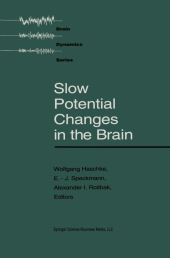 Neuerscheinungen 2012Stand: 2020-01-07 |
Schnellsuche
ISBN/Stichwort/Autor
|
Herderstraße 10
10625 Berlin
Tel.: 030 315 714 16
Fax 030 315 714 14
info@buchspektrum.de |

Haschke, Speckmann
(Beteiligte)
Slow Potential Changes in the Brain
Softcover reprint of the original 1st ed. 1993. 2012. xxii, 288 S. 93 SW-Abb. 235 mm
Verlag/Jahr: SPRINGER, BASEL; BIRKHÄUSER BASEL 2012
ISBN: 1-475-71381-9 (1475713819)
Neue ISBN: 978-1-475-71381-7 (9781475713817)
Preis und Lieferzeit: Bitte klicken
DC-potential changes, comprising fast fluctuations and slow shifts, rep resent objective concomitants of neuronal processes in the brain. They can be recorded not only in animals, but also in humans under various conditions. As far as slow brain potentials are concerned, exciting results have been detected with respect to their correlation to psychophysiolog ical events. Although a large amount of data has been accumulated by psychophysiologists, neurophysiologists, and other scientists involved, the neurophysiological basis of these field potentials is still not clear, and remains controversial. Scientists from European countries participated in an interdisciplinary symposium in the summer of 1990, July 2 to 6, at the Friedrich Schiller University in Jena, which covered the field of slow brain potentials from the psychophysiological to the cellular level, including glial cells and microenvironment. From this conference the idea derived to present an up-to-date overview on important aspects of the field concerned. The Introductory Remarks are given to elucidate what is thought to be a "generator" of slow potentials of the brain. The large number of sources, implications of the "inverse problem" to analyze field potentials are taken into account.
Introductory Remarks.- 0 What is a Generator Like?.- I. Overview.- 1 DC Potentials of the Brain.- 2 Activity of Single Neurons and Their Relationship to Normal EEG Waves and Interictal Epilepsy Potentials in Humans.- II. Psychophysiology.- 3 Determinants of CNV Amplitude.- 4 Changes of Slow Brain Potential Shifts Following Failure.- 5 Association Cortex Contributions to the Human P3.- 6 Interactions between the DC Potential of the Brain and Slow Potential Shifts under Mental Load.- 7 The "Oddball CNV" as Indicator of Information Processing in Healthy Subjects and Patients with Panic Disorders.- 8 Lateralization of Slow Brain Potentials and Preparatory Processes.- III. Neurophysiology.- 9 The Genesis of Cortical Event-Related Potentials: Excitatory and Inhibitory Contributions.- 10 Prolonged Unstable Depression: A Modified Manifestation of Spreading Depression in Rat Hippocampus.- 11 Modulation of Glutamate Responses by Noradrenaline and GABA in Neo- and Archicortical Structures.- 12 Extracellular Changes of Aspartate, Glutamate, and Taurine in Relation to DC Changes during Complete Cerebral Ischemia and Cortical Spreading Depression.- 13 Evoked Field Potentials-Beyond Correlates of Behavior: An Approach to Determining the Neural Mechanism of Behavior.- IV. Glia and Microenvironment.- 14 Cortical Slow Potentials, Depolarization of Glial Cells, and Extracellular Potassium Concentration.- 15 Voltage- and Ligand-Gated Membrane Currents of Identified Glial Cells in the Hippocampal Slice.- 16 Contributions of Extracellular Potassium Increases to Transient Field Potentials (Review of Data).- 17 Cornea-Negative and Cornea-Positive Slow Components of the ERG and Light-induced Extracellular Potassium Changes.- V. Biomagnetism.- 18 Magnetoencephalographic Signals and Their Registration.- 19 Neuromagnetism and Source Location.- 20 Measurement of Neuromagnetic Signals.- 21 Extracranial Slow Magnetic Field Changes during Epileptic Activity.- VI. Motor Control.- 22 DC Shifts and Event-related Potentials Associated with Workload in a Dual Task Situation.- 23 Frontomesial Activation during Spatial Bilateral Coordination: Tentative Conclusions on SMA Function.- 24 Phasic and Tonic Changes of the Mean Alpha Frequency (MAF) of the EEG during Motor Performance.- 25 Changes of CNS Activation Patterns during Motor Imagination.


